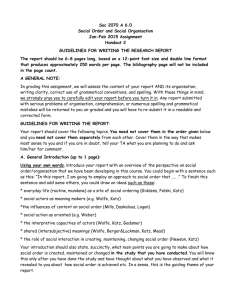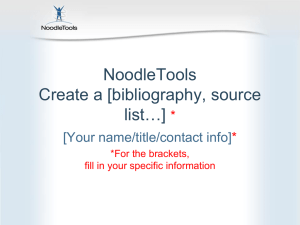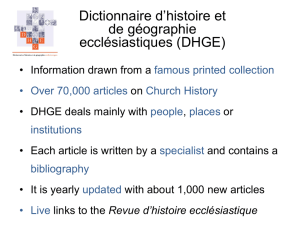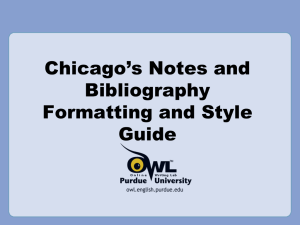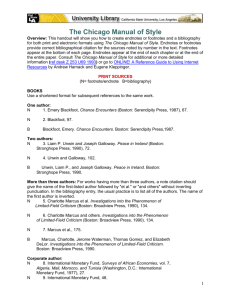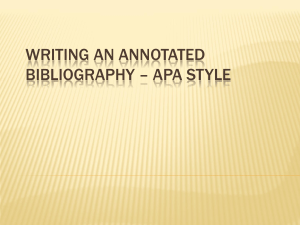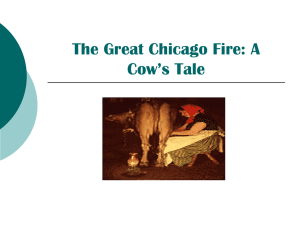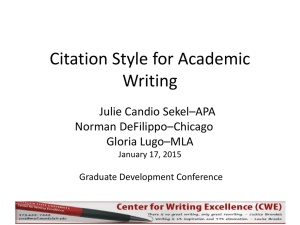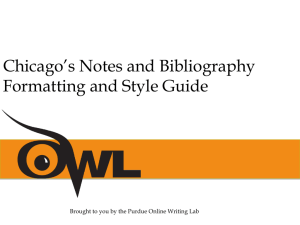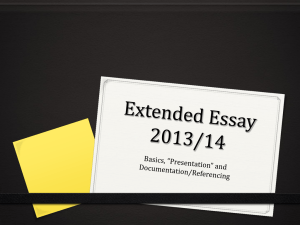Chicago/Turabian Style Tutorial
advertisement
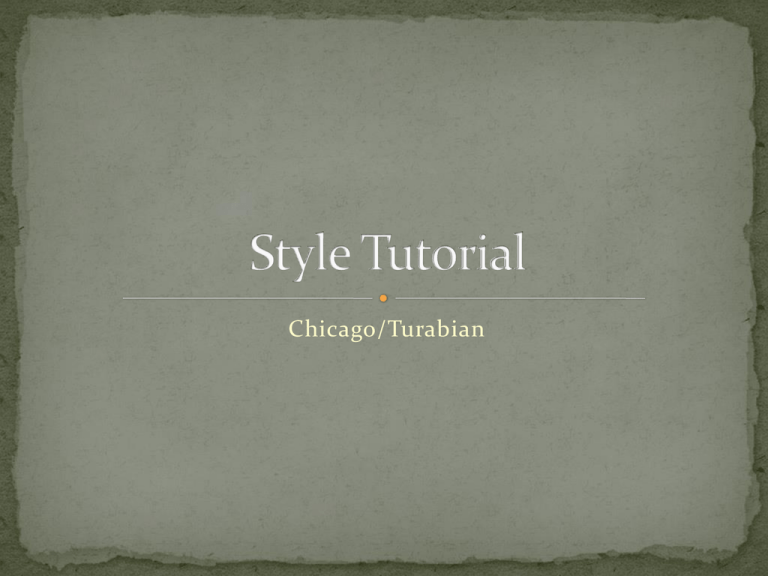
Chicago/Turabian History Art Philosophy Business Communications Formatting Issues Internal Citations/Footnotes Bibliography Credible Sources The first thing to do in any tutorial is to discover what the student needs and answer his/her questions. Typical questions: Is my format correct? How do I ____________? Incorporate parenthetical citations Create footnotes Etc. Are my footnotes correct? Is my bibliography set up right? We cannot help with subject content, but we can help with the structure of the student’s argument. Make sure that the student understands that if they prioritize formatting or style concerns, there will not be much time left in the tutorial to address content concerns or structure issues. Formatting: Margins: 1 inch Font: Times New Roman, 12 pt. Courier, 12 pt. Paragraph: Double space Header: Page numbers start on the second page with page number two (2). (below directly from Purdue OWL) Chicago has an optional system of five heading levels. Chicago Headings Level Format 1. Centered, Boldface or Italic Type, Headline-style Capitalization 2. Centered, Regular Type, Headline-style Capitalization 3. Flush Left, Boldface or Italic Type, Headline-style Capitalization 4. Flush left, roman type, sentence-style capitalization 5. Run in at beginning of paragraph (no blank line after), boldface or italic type, sentence-style capitalization, terminal period. Block quotes: Formatted like APA, but block quotes start at 100 words or more—or at least eight lines. Capitalizations: “Capitalize the first word in a direct quote. Do not capitalize a direct quotation when it is blended into the main sentence” (Houghton 2008, 16). Above citation is an example of Turabian Author-Date Style. Full citation would be found in a reference list: Houghton, Peggy M. 2008. The Chicago Manual of Style: The Easy Way. Flint, MI: Baker College. Ellipses: Omissions are indicated using ellipses free of brackets. Author-Date Style Full source following quote: “Ex: …” (Robert K. Yin, Case Study Research: Design and Methods [Thousand Oaks: SAGE Publications, 2003], 83). Ex: As stated in Yin’s Case Study Research: Design and Methods (SAGE Publications, 2003), the design of the study is extremely important. Ibid: “Used [to replace the] bibliographic information in the second parenthetical reference if the passage is from the same source and is cited closely to the first” (Peggy M. Houghton, The Chicago Manual of Style: The Easy Way [Flint, MI: Baker College, 2008], 20). Ex: (ibid., 85) Bibliography: Title the Bibliography “References” (below direct examples from CSM: The East Way) Paraphrase in text: In the military, publicly berating a subordinate in order to 1 achieve positive behavioral change is accepted. Footnote: 1. Anthony J. Bonanno, Argumentative Strategies in the Military, (Chicago: Sinclair Books, 2008), 212. Bibliography: Bonanno, Anthony J. Argumentative Strategies in the Military. Chicago: Sinclair Books, 2008. (below direct examples from style manual): Quote in text: He concludes that “being a person is not a pat formula, but a 1 quest, a mystery, a leap of faith.” Footnote: 1. Jaron Lanier, You Are Not a Gadget: A Manifesto (New York: Alfred A Knopf, 2010), 5. If cited again, source information can be shortened: 5. Lanier, Not a Gadget, 133-34. Bibliography: Lanier, Jaron. You Are Not a Gadget: A Manifesto. New York: Alfred A. Knopf, 2010. (Below from Purdue OWL) Leave two blank lines between “Bibliography” or “References” and your first entry. Leave one blank line between remaining entries. List entries in letter-by-letter alphabetical order according to the first word in each entry. Use “and,” not an ampersand, “&,” for multi-author entries. For two to three authors, write out all names. For four to ten authors, write out all names in the bibliography but only the first author’s name plus “et al.” in notes and parenthetical citations. When a source has no identifiable author, cite it by its title, both on the references page and in shortened form (up to four keywords from that title) in parenthetical citations throughout the text. Write out publishers’ names in full. Do not use access dates unless publication dates are unavailable. If you cannot ascertain the publication date of a printed work, use the abbreviation “n.d.” Provide DOIs instead of URLs whenever possible. If you cannot name a specific page number when called for, you have other options: section (sec.), equation (eq.), volume (vol.), or note (n.). Chicago: The Easy Way A Writer’s Resource
